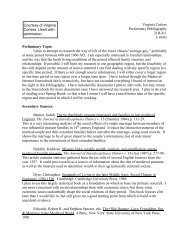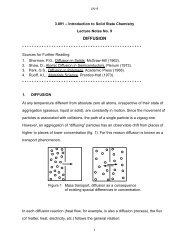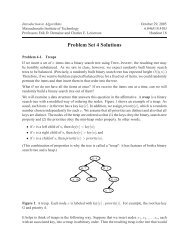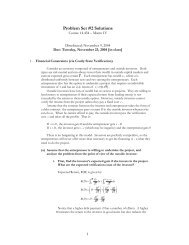Using Foreign Languages in the Middle Ages
Using Foreign Languages in the Middle Ages
Using Foreign Languages in the Middle Ages
You also want an ePaper? Increase the reach of your titles
YUMPU automatically turns print PDFs into web optimized ePapers that Google loves.
those who orig<strong>in</strong>ally spoke it.<br />
Lat<strong>in</strong> orig<strong>in</strong>ally became <strong>the</strong> language of Roman Christianity to make Christian teach<strong>in</strong>gs<br />
more accessible to <strong>the</strong> masses. In <strong>the</strong> 5th century, St. Jerome translated <strong>the</strong> Bible from<br />
Greek <strong>in</strong>to socalled Late Lat<strong>in</strong>, <strong>the</strong> language of <strong>the</strong> Roman plebs. All Christians <strong>the</strong>refore<br />
<strong>the</strong>oretically had direct access to <strong>the</strong> Bible, even if <strong>in</strong> practice teach<strong>in</strong>gs usually came through<br />
21 a Priest speak<strong>in</strong>g Late Lat<strong>in</strong>. Gradually, however, <strong>the</strong> gap between Romance dialects and<br />
Late Lat<strong>in</strong> widened. St. Jerome’s translation and <strong>the</strong> Lat<strong>in</strong> language itself came to be<br />
seen as sacred, and symbolic of <strong>the</strong> church’s authority. In an 865 exchange of letters, Pope<br />
Nicholas defended Lat<strong>in</strong> aga<strong>in</strong>st <strong>in</strong>sults from Constant<strong>in</strong>ople, and demanded that it be seen<br />
22<br />
as a sacred language, like Greek and Hebrew, but this was an extreme view for <strong>the</strong> time.<br />
In communication to <strong>the</strong> 9thcentury mission to <strong>the</strong> Slavs, Pope John VIII wrote that ”<strong>the</strong>re<br />
is noth<strong>in</strong>g contrary to <strong>the</strong> faith or to sound doctr<strong>in</strong>e <strong>in</strong> s<strong>in</strong>g<strong>in</strong>g mass <strong>in</strong> <strong>the</strong> said Slavonic<br />
language,” 23 contribut<strong>in</strong>g to <strong>the</strong> creation of Cyrillic script and mass <strong>in</strong> Slavic languages.<br />
Rome panicked, and tried <strong>in</strong> va<strong>in</strong> for decades <strong>the</strong>reafter to ensure that only Lat<strong>in</strong> be used<br />
24<br />
<strong>in</strong> Slavic services.<br />
Over time, knowledge of Lat<strong>in</strong> came to symbolize <strong>the</strong> mediat<strong>in</strong>g function of priests and<br />
dist<strong>in</strong>guish <strong>the</strong>m from o<strong>the</strong>r members of society. The fact that most parishioners (and some<br />
priests) could not understand <strong>the</strong> Lat<strong>in</strong> mass became acceptable because priests were meant<br />
25 to <strong>in</strong>terpret <strong>the</strong> Word. The beautiful pictures seen <strong>in</strong> illum<strong>in</strong>ated manuscripts and sta<strong>in</strong>ed<br />
21 Banniard (1999), pp. 229230.<br />
22 Richter (1976), p. 49.<br />
23 Richter (1975), p. 77.<br />
24 Richter (1976), p. 53.<br />
25 Banniard (1995).<br />
8


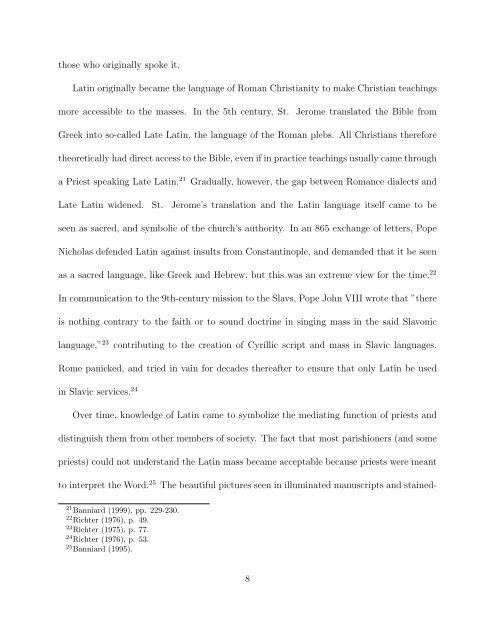
![18.03 Class 21, April 3 Fun with Fourier series [1] If f(t) is any decent ...](https://img.yumpu.com/51148985/1/190x245/1803-class-21-april-3-fun-with-fourier-series-1-if-ft-is-any-decent-.jpg?quality=85)

